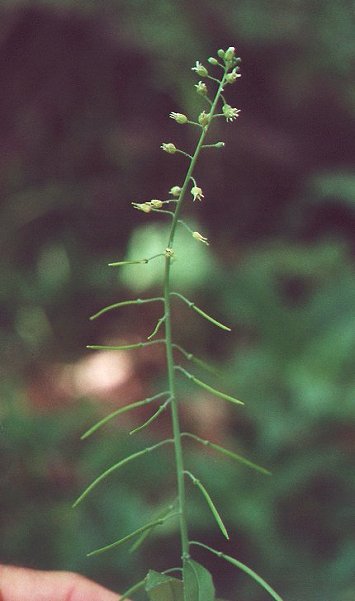Borodinia canadensis (L.) P.J. Alexander & Windham
Sicklepod

Native
CC = 4
CW = 5
MOC = 0
© DETenaglia
Borodinia canadensis (L.) P.J. Alexander & WindhamSicklepod | |
 |
Native CC = 4 CW = 5 MOC = 0 |
© DETenaglia |
|
Family - Brassicaceae Habit - Biennial forb from taproot. Stems - Erect, to 1 m, simple to few-branched above, glabrous or sparsely pubescent with mostly unbranched hairs toward the base.
Leaves - Alternate, simple. Basal leaves usually withered at flowering, to 12.0 cm, obovate to lanceolate, entire to sharply toothed, narrowed at the base to a short petiole, pubescent on both surfaces with unbranched and much fewer, stalked, forked hairs. Stem leaves mostly sessile, elliptic, not clasping, to 10 cm, narrowed at the base, the lower leaves sometimes short-petiolate, entire to toothed, the upper leaves often glabrous, the lower leaves hairy.
Inflorescence - Terminal raceme, elongating in fruit to 30 cm. Pedicels to 8 mm long, sparsely pubescent, perpendicular to axis at anthesis, drooping in fruit.
Flowers - Sepals 4, 2-4 mm long, oblong-elliptic, 3 mm long, 1.2 mm broad, erect, pubescent, often yellow or purple-tinged. Petals 4, free, 3-5 mm long, 1 mm broad, white, glabrous, slightly exceeding sepals, linear. Stamens 6, not exceeding petals. Filaments white, 2.1mm long, glabrous. Anthers pale yellow. Ovary green, 2mm long, terete, glabrous.
Fruits - Siliques to 10 cm long, 2 mm broad, slightly compressed or flattened, arched downward at maturity. Seeds in 1 row in each locule, 1.3-1.6 mm long, oval to nearly circular in outline, flattened, strongly winged, the surface with a reticulated pattern of ridges and pits, orange.
Flowering - April - June. Habitat - Forest openings, rocky slopes and ledges. Origin - Native to the U.S. Lookalikes - B. laevigata, B. dentata, and other members of the genus. Other info. - This tall but relatively inconspicuous species occurs throughout most of Missouri, particularly in rocky areas, on both acidic and calcareous substrate. It is found throughout the Midwest and into New England and a bit of Canada. Its appearance is perhaps most interesting in fruit, when the long curved siliques arch downward from the stem. Photographs taken at the Parkville Nature Sanctuary, Platte County, MO., 5-5-00, and in Eminence, MO., 6-8-01 (DETenaglia); also at Rockwoods Reservation, 5-23-2008, Silver Mines Recreation Area, 5-12-2015, and Shaw Nature Reserve, Franklin County, MO, 5-14-2022 (SRTurner). |